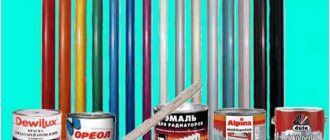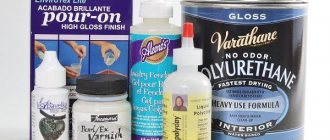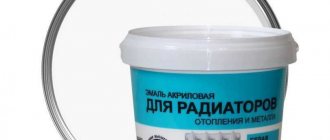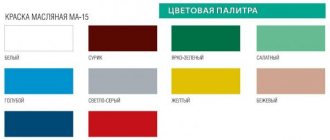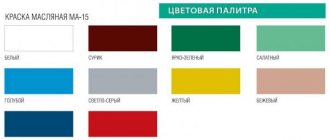A situation with a leaking heating circuit is not uncommon, since the heating system consists of many components and elements, the tightness of their connection with each other is sooner or later broken. In addition to joints, a depressurization zone can also be an entire span of pipe that is physically worn out or damaged due to the influence of some factor.
Sealant for heating pipes, available in different types and designs, helps solve the problem of a leak or ensure long-term tightness of the connections of its elements during installation of the system.
Why is sealing needed?
Sealing in a heating system usually means the elimination of open and hidden leaks that occur in any area. In fact, this problem falls into the category of emergency situations and requires an urgent solution, as well as strict adherence to technology when carrying out work. In addition to isolating cold or hot water leaks, sealing may be needed in the following cases:
- for laying water supply pipes;
- when installing threaded connections;
- for sealing the heating boiler lid;
- for installing heated floors;
- to strengthen the radiator connections after disassembling into sections.
CO sealant is a universal self-sealing solution that helps eliminate leaks in pipes and joints. Most sealants are suitable for interior and exterior work; they can be poured into the expansion tank and other areas of the water system.
The use of sealant allows you to restore the functioning of the CO in a short time, without compromising the integrity of the walls and floors. Sealants are especially often used when the pipes in the house are in a place inaccessible to open operations, as well as when it is impossible to eliminate the leak by soldering or applying a clamp.
Popular brands
The market offers sealing materials for stoves, fireplaces and chimneys. They are selected according to their composition and operating temperature. It is recommended to use products from reputable manufacturers.
Soudal
Soudal (Saudal) is a Belgian company that specializes in the production of sealing compounds. Soudal sealant for stoves and fireplaces is the Soudal series.
Calofer, heat-resistant compounds in black. Materials based on sodium silicate do not emit toxic substances when heated and can be painted. Suitable for sealing cast iron elements of boiler units. One of the advantages of Belgian products is their resistance to cracking and crumbling.
Penosil
An Estonian company produces silicate paste for Penosil +1500 ovens. The material has high heat resistance and is black in color. Foam is cheaper than the products of the famous Belgian manufacturer, but is not inferior in quality. This makes Estonian sealant widely in demand among professionals and home craftsmen. The company's product line also includes the silicone sealing compound Penosil Hight Temp, suitable for use for moving joints due to its elasticity.
Tytan
Under this brand, sealing compounds are produced by the Selena Group, a group of Polish manufacturers of professional materials for construction and finishing. The sealing paste contains fiberglass, which provides the sealed seams with increased gas tightness. The material is designed to be heated to high temperatures (1250 degrees), which makes it suitable for sealing seams and cracks in fireplace and stove masonry, and for installing chimneys. Products of the Tytan brand, as well as sealants with similar properties, which are produced under the Baumaster brand, belong to the middle price category. In terms of price and quality ratio, this is the best option for a wide range of consumers.
Makroflex
A well-known Estonian manufacturer of sealing materials supplies the market with fire-resistant silicate composition Makroflex HA147. It can withstand short-term heating up to a high temperature of +1500 degrees and exposure to an open flame. The advantages of the paste of inorganic materials include adhesion to most materials used in construction and the absence of shrinkage upon drying and under the influence of temperature fluctuations.
Krass
The Russian manufacturer offers the refractory composition “Krass fireplaces and stoves”. Using this material, fireclay masonry and fireproof masonry can be installed in the furnace firebox. The composition can withstand sudden increases in temperature, is not afraid of open fire, and is suitable for repairing brick stoves and fireplaces, as well as heating boilers. This is a non-shrinking material made on the basis of liquid glass. Thanks to its paste-like consistency, it is easy to apply.
Basic requirements for compositions
The sealant can be used for polypropylene, bimetallic, and other heating system pipes. But before purchasing, it is important to clarify that its characteristics correspond to a particular pipe material, because compositions for plastic are not suitable for metal networks. You can get acquainted with such information on the packaging, where exact data on the composition and properties are always indicated.
In addition, the sealant must meet the following requirements:
- Resistance to adverse factors. The water in the pipes is under pressure, and it is also hot. Therefore, the product must be moisture resistant and not responsive to temperature changes or aggressive chemical environments. If the sealant is used in steam systems, it must be high temperature (heat resistant).
- Long service life. The operating time of the entire CO depends on this factor. If the sealant is reliable, the system will work for at least 5-10 years. The cost of such funds is usually quite high.
- Elasticity. Sealants against leaks after hardening must remain plastic. This way they will easily, without destruction or detachment, tolerate the expansion and contraction of the base material that inevitably occurs with temperature changes.
Results
As with all building materials, sealants also need to be understood. High-temperature sealants are a very narrow and specific segment, but even here there are many nuances, ignorance of which can lead to errors and insufficient tightness of products.
The choice of building materials for installation and repair work with brick fireplaces is strictly limited by such parameters as heat resistance, adhesion, and environmental safety. The need to use such substances arises even at the stage of construction of fireplaces or stoves. The difficulty lies not only in the high temperature of the working unit, but also in the difference in the coefficients of thermal expansion for different elements.
Types of sealants for heating systems
The choice of sealant is determined not only by the material of the pipes, but also by the type of coolant used and the presence of a heat exchanger. If you choose the wrong product, pipes can become clogged anywhere in the heating system. Various substances can be used as a coolant, and the sealant should not react or be destroyed by contact with them. Based on this criterion, agents are divided into those that can come into contact:
- with water (regular, softened with complexons or magnetized);
- with antifreeze;
- with oils;
- with gas or steam.
A separate line includes sealant for cold water pipes, which is also applied to the threads of faucets and is used to seal joints. The consistency of sealants can be fluid or paste-like. Pipe sealant can also be classified according to its physical properties:
- Drying compounds. As they polymerize, they become completely dry. If the application and drying technology has been violated, the products may shrink and quickly crack.
- Non-drying compounds. Ideal for removing small leaks and sealing threads, although they can be squeezed out at joints under pressure.
Among the popular brands of sealants are Aquastop 2100, BCG, Block Seal 100. Based on their composition, the products are divided into several groups, which are described below.
Oligomer based
Depending on the functional group used in production, such products are divided into polysulfide and polysiloxane. Sealants made from polysulfide oligomers are used much more often for heating systems. They have a unique set of properties: oil resistance, gasoline resistance, gas impermeability, weather resistance, and the ability to operate for a long time in different temperature ranges.
Acrylic
Most acrylic products are not suitable for repairing CO in a private house or apartment. Only some brands are able to withstand temperature changes and boast heat resistance. For example, anaerobic sealants are suitable for sealing pipes and radiators - a type of acrylic compositions that, when released into an airless environment, fill the entire closed volume (crack, chip) and form a homogeneous polymer mass.
Such products can withstand high temperatures, they are very durable and elastic. Seams and joints can subsequently be cleaned with acidic and alkaline substances, since sealants are sufficiently resistant to chemicals. And yet they have one drawback: dismantling the structure will be very difficult, since it becomes monolithic.
Thiokols
Such materials can be used at temperatures of -20...+40 degrees, that is, they are not heat-resistant. Therefore, they are used only in construction for sealing interpanel joints, double-glazed windows, plumbing equipment and are not used for repairing CO.
Silicone
Such funds are considered universal and most in demand. Most silicone sealants are high-temperature and therefore suitable for work in CO environments. They can be liquid or paste-like, the latter having thixotropic properties (do not flow after application). The technical characteristics of silicone compounds are as follows:
- possibility of operation at -60…+300 degrees;
- penetration even into the smallest cracks and depressions;
- adhesion to any surfaces;
- hardening at room temperature;
- resistance to moisture and aggressive chemicals;
- elasticity;
- environmental Safety;
- strength;
- durability.
When purchasing silicone sealant, you need to pay attention to its specific type. The products are neutral and acidic, and the latter can cause corrosion of metals, so they are not suitable for metal pipes.
Polyurethane
Polyurethane-based products are produced in one- and two-component forms. The first ones are inexpensive, but they dry much longer. The latter, after reacting with the hardener, quickly undergo polymerization, resulting in the creation of a strong, elastic connection. Polyurethane compounds are suitable for all types of materials, including metals; they do not provoke corrosion; on the contrary, they protect parts from damage. Sealants are durable, resistant to aggressive chemicals and mechanical stress, and are characterized by low consumption.
Liquid sealant for heating system
Liquid sealant has to be used where there are hidden leaks and there is no access to the place where the defect appears. The material is poured into the damaged pipe along with the coolant. In the area of the crack, the sealant inevitably comes into contact with air and begins to polymerize, sealing the defect. Among the liquid options there are those that work in water, antifreeze, and are suitable for metal or plastic pipes.
Seals
Radiator sealant is also successfully used for all threaded connections. Sometimes it is used instead of (or together with) FUM tape, which has completely replaced flax tow. There are liquid and paste formulations. They can harden completely or remain elastic throughout use.
Among the pastes, the Unipack brand is popular. It does not harden and contains flax fibers. Its main advantage is the ability to protect the joint from corrosion. And if necessary, it can be easily removed.
Anaerobic drying pastes are vibration resistant and can withstand temperatures up to +200 °C. Their only disadvantage is the inability to tighten the threaded connection if necessary. In this case, all tightness is immediately broken. Among the products, the PERMATEX brand is in wide demand.
Technology and methods of using sealant for heating systems
To begin with, it is important to choose the appropriate composition and accurately calculate its quantity, which directly depends on the volume of coolant. Typically, 1 liter of sealant is used for 60-80 liters of liquid.
External treatment
External operations include work on sealing joints and threaded connections. They need to be done in this order:
- drain the liquid from the CO;
- find the damaged area;
- clean the defect area from dust, dirt, old sealant;
- degrease;
- apply a new composition;
- wait for it to dry;
- pour coolant into the system.
Internal processing
If you need to fill the sealant inside the CO, you need to purchase a liquid product. Water from the heating system is drained into appropriate containers, and the sealant is diluted with water. The Mayevsky valve is unscrewed from the radiator, and a pump is attached in its place. The system is filled with liquid with sealant, the pressure is increased to 1.5 atmospheres. After 6-8 hours the sealant completely hardens.
Then the coolant is drained again, and a new one is introduced instead (without sealant). In this way, another 2-3 repetitions of operations are performed, which is required to remove the remnants of uncured sealant from the pipes. After 3 days, check for defects and cracks. If necessary, the process is repeated again. If the water leak is more than 30 liters per day, sealing is pointless: only a major overhaul by replacing a piece of pipe will help.
How the authorities of Sevastopol created problems for the state port
According to information available to ForPost from its own sources, on the evening of January 17, in the government of Sevastopol, employees of special services were indeed seizing documents in the case of the possible deliberate bankruptcy of the Sevastopol Sea Port. It is for this reason, the source reports, that the regional governor, Dmitry Ovsyannikov, refused to meet with Syrian President Bashar Assad during a trip abroad and flew to Sevastopol.
Let us recall that earlier a number of online sources and alternative media reported about a conflict that flared up within the walls of the city-regional government around the anti-corruption unit, which discovered possible traces of the deliberate bankruptcy of Northern Seaport.
Official sources
At the same time, public sources contain enough information indicating that the government structure of Dmitry Ovsyannikov took steps that likely have a chance of creating great financial difficulties for Sevmorport.
The point is that at the end of 2022, the Department of Property and Land Relations of Sevastopol flooded Sevmorport with lawsuits for debt collection. Let's give a few such examples.
The Sevastopol Arbitration Court made the first decision in favor of the government on October 30, 2022, obliging Sevastopol Sea Port to recover 1 million 750 thousand rubles of debt for renting a land plot (a warehouse located on the 5th km of Balaklava Highway) for the period from September 29, 2017 to 05/31/2018
The second decision to collect 265 thousand rubles of debt in favor of the government for renting a land plot in Kamyshovaya Bay (with berths No. 221, 222, 223, 224, 225, 227, 228, 229, 230) was made by the Arbitration Court on November 13, 2022.
And on November 28, 2022, the Arbitration Court of Sevastopol made a third decision - to recover from Sevmorport 687 thousand rubles of debt for renting a land plot on Rybakov Street, 5.
Unprofitable enterprise
Thus, the state enterprise “Sevastopol Sea Port”, created by the government of Sevastopol itself in June 2014, at the end of 2022 found itself with debts of more than 2.7 million rubles only based on the results of three ships. Add to this the likelihood of other financial problems that we are not yet aware of, as well as the fact that as of the last reporting year, Sevmorport had a negative profit of about 1.94 million rubles, and we get a very unfavorable picture.
Why a state-owned enterprise established by the government of Sevastopol, which includes the entire maritime infrastructure of the region associated with maritime cargo and passenger transportation, found itself in such a situation is a big mystery.
Preparatory work before using sealant
To prepare the system, all taps are unscrewed and filters are removed. This is necessary to bleed air and water (antifreeze). To find a leak, the pipes should not be wet: for this purpose, a pump is installed on the first radiator, which will remove remaining air and heat the inner surface of the pipeline to +50...+60 degrees.
Preparing the sealant
The rate of adding a sealing compound may vary depending on its type and brand. The concentration of the product must be calculated as accurately as possible, otherwise the effectiveness will be low. For this purpose, you must carefully read the instructions and determine the volume of coolant. You can perform the calculation using the following methods:
- Direct freezing. Take containers of a known size, pour water from the pipes into them, and determine the total volume of liquid.
- Indirect freezing. Calculate the total length of the pipes, multiply by their cross-sectional area, add the volume of the boiler and radiators to the indicator (they can be viewed in the product data sheets).
Afterwards, you need to determine the amount of sealant according to the instructions for the specific product. Usually it does not exceed 1 liter per 80 liters of coolant. The two-component sealant must be mixed immediately before use, combining the two substances according to the proportion indicated in the instructions.
Setting up a heating system for filling
To prevent the sealant from hardening in the pipes prematurely, without reaching the leak site, it is important to completely remove air from the CO. After removing the filters and unscrewing the taps, the automatic pump is turned on for 2 hours - this is enough to remove the remaining gas.
Pouring sealant
A solution of water and sealant is prepared in a large container and mixed well. The liquid is immediately introduced into the heating system using a pump - a high speed of work will help reduce the risk of contact with air. After CO it starts in normal mode with a water temperature of about +50 degrees.
Control measures are carried out after 3-5 days - they help to check whether the sealing was carried out efficiently. It is also advisable to carry out pressure testing - launching CO under pressure, for which it is better to invite an experienced specialist.
Heat-resistant (silicone) pastes
The maximum temperature limit of 250-300°C allows the use of such compositions in external finishing, restoration of the outer layer of the portal, in joining sandwich pipes and when processing them in places where they pass through the ceiling. The main substance here is silicone. Depending on the impurities, the maximum temperature for which the paste is designed may have different values.
Typically, silicone sealants have a red tint. This indicates that it contains iron compounds.
In their variety, heat-resistant sealants are divided into acid-containing and neutral. In the kiln business, neutral pastes are used, since the acid released when the substance hardens has a strong, unpleasant odor. Crystallization of neutral sealants is accompanied only by the release of water or alcohol. In addition, acid has a detrimental effect on sealed seams.
In order to resolve the issue of the applicability of silicone sealant, its main properties should be highlighted.
- The finished composition is not subject to destruction by ultraviolet radiation. This allows this type to be used not only indoors, but also on the streets.
- Bonds well to various types of surfaces. The only condition is their preliminary preparation (removal of dust, wetting).
- Waterproof properties make this type of sealant an indispensable option when sealing the outlet of a chimney pipe through the roof.
- The plasticity of the finished substance will not allow destruction during thermodynamic changes. The sealant is excellent as an adhesive element when facing fireplaces.
- Possibility of use in mechanized devices.
In order for the heat-resistant sealant to efficiently perform its functions, it is necessary to wait until the paste has completely hardened before lighting the fireplace. This may take up to several days. Detailed information is provided by the manufacturer.
The need for compaction
Sealing sewer pipes, like sealing all water pipes, is a very essential step in the pipeline installation process.
It is especially important to perform high-quality sealing of joints
To prevent the pipeline from leaking, since the appearance of unpleasant odors in an apartment or private house depends on this, it is necessary to choose the right seal for sewer pipes.
This means that you need to know which sealant is best for sealing plastic, polypropylene, cast iron, steel and other products. You also need to have information about how to seal threaded connections of a water supply system, couplings, and flanges.
You need to familiarize yourself with other materials necessary for the repair or installation of heating systems, gas supply, repair of sewers designed for draining acids and alkalis, and other systems, so that, if necessary, you can do such work yourself.
Now let’s talk about how to seal any pipe in order and in more detail.
Peculiarities
Thanks to sealing compounds, the construction and renovation process becomes simple and fast. With their help, you can reliably fasten various surfaces together without nails or a hammer, use them as a sealing agent and for sealing cracks and cracks. When installing windows or troubleshooting minor problems in everyday life, they are indispensable, saving money and time. Their use allows pipes to be repaired without opening walls or removing plumbing structures.
Liquid sealant is currently stronger than glue, but not as “heavy” as mortar.
The sealing liquid has a number of properties:
- does not change its characteristics under the influence of high temperature;
- is moisture resistant;
- withstands heavy loads.
The liquid solution is one-component, comes in tubes and is ready for use. The product for larger-scale work is available in canisters of various sizes.
What to look for when choosing?
- When heading to the store, you should already have an idea of what kind of work you need a sealing agent for. This is the first thing the seller will ask you.
- In addition, try to study in detail the instructions (it should be on the packaging) of what you will be offered.
- Determine whether the composition is for interior or exterior use.
- There must be an indication of the type of work (plumbing, roofing, etc.).
- Properties of the sealant - whether it has heat resistance or elasticity.
- Check if it suits your color.
- If there is an indication on the packaging that it belongs to the professional group, keep in mind that it is more difficult to work with, and additional knowledge of its features is required.
- Is it possible to use it in a pistol?
Pros and cons of using liquid polymer materials in plumbing
Manufacturers claim that anaerobic sealants are an ideal material with no disadvantages. However, professional craftsmen were able to discover several minor disadvantages during use.
| Advantages | Flaws |
| The compound does not lose its properties at temperatures in the range of -196º, -60º to 150-300ºС. High resistance to mechanical and dynamic loads. Economical material consumption. Neutrality to aggressive environments and vibrations. After hardening, it does not dissolve in water. Possibility of reliable connection of materials of different structures. Resistance to high pressure: about 50 atmospheres and above. | Dependence on low temperatures - hardening time increases. Limited use - not recommended for sealing pipes with a diameter of M80 and above. Sensitivity to moisture - applied only to dry surfaces. They provide strong fixation and are therefore suitable only for permanent connections. |
Some installers express dissatisfaction with the high cost of products. However, the price seems quite justified, given the quality and economical consumption of the composition.
3
Types of compounds - what are the means for fixing compounds?
To be able to use the composition when installing different degrees of complexity, there are several types of sealants on the market. The main difference between them is their viscosity, fluidity and ability to penetrate into the thinnest crevices. In addition, the product can be intended not only for sealing threaded connections, but also for fixing fittings, flanges and bushings. On the container of the composition there are always tables and instructions with the help of which it will be possible to determine the suitable areas of its use.
Depending on the degree of strength, sealants are divided into three types: standard, medium and high strength compositions. Products of the first category are used to work with connections that, as a rule, are not subject to vibration. These compounds are also used in cases where pipes need to be dismantled frequently. The stall power of such devices ranges from 4–9 Nm. This allows you to remove hardened sealant without the use of special tools.
Waterproofing with anaerobic sealant
Medium strength compounds are used in service and repair work to secure connections exposed to vibration or high pressure. In such sealants, the breaking power ranges from 15 to 22 Nm. Dismantling of this type of product requires the use of tools or heating with fire. Third class sealants are used for threaded connections that are not planned to be removed in the next few years. Such products can withstand the strongest vibrations and very high pressure. To break a connection treated with such a sealant, a force of at least 55 Nm is required.
Plumbing thread
Plumbing threads , advertised in large quantities, seal threaded connections well, but with a large number of connections, and in the heating system of a private house or cottage there are dozens of threaded connections, they will be too troublesome and expensive sealing material.
In fact, a plumbing thread from any manufacturer is a FUM tape reduced to the thickness of the thread, albeit from other materials, but the principle is the same. Like FUMka, the thread is wound onto the thread, and then the connection is assembled.
Why is tightness needed?
Brick stoves and fireplaces are prone to cracking due to uneven heating of the masonry, especially if it is not protected by a layer of plaster or tiles. If the cracks in the body of the heating unit turn out to be through, this entails unpleasant consequences
:
- fuel is consumed faster because it burns under conditions of additional oxygen;
- soot may enter the room and settle on the walls and ceiling;
- combustion products enter the room, primarily carbon dioxide, which can cause poisoning.
Cracks in a brick chimney, cracks in a metal pipe for removing combustion products reduce draft, and the heating unit cannot operate in optimal mode. This causes the fuel to burn at lower temperatures, producing a lot of ash and more soot deposited on the inside of the chimney.
A large amount of soot and a leaky chimney is a dangerous combination. The intake of air causes the soot to ignite, and it burns at temperatures above 1500°C, causing the chimney to heat up. An insufficiently thick layer of thermal insulation around the pipe will not save wooden structures from charring; there is a serious risk of fire.
For gas boilers, a leak in the chimney results in gusts of wind extinguishing the burner. To avoid the need to regularly check the operation of the boiler, the gaps in the chimney duct are sealed with a special sealant.





